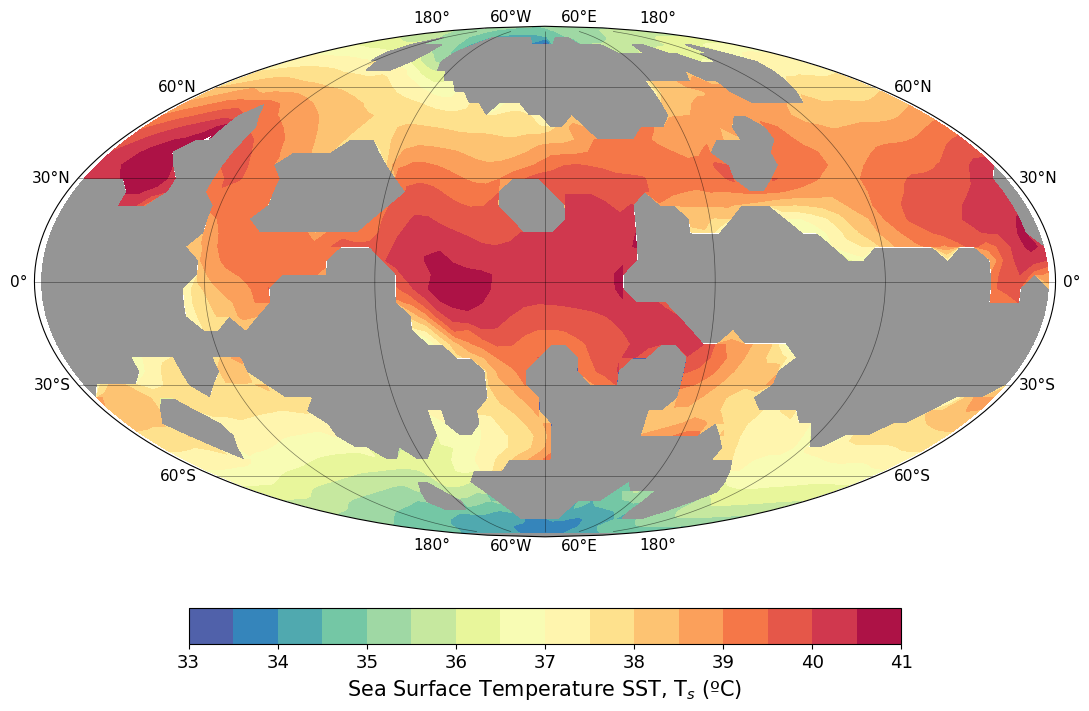Ocean circulation on the paleo Venus with ROCKE-3D
- 1University of Lisbon, Faculty of Sciences, Lisbon, Portugal (dfquirino@fc.ul.pt)
- 2Instituto de Astrofísica e Ciências do Espaço (IA), Universidade de Lisboa, OAL, Edifício Leste, Tapada da Ajuda, 1349-018 Lisbon, Portugal
- 3Instituto Dom Luiz (IDL), Faculty of Sciences, University of Lisbon, 1749-016 Lisbon, Portugal
- 4NASA Goddard Institute for Space Studies, New York, NY, USA
- 5GSFC Sellers Exoplanet Environments Collaboration, Greenbelt, MD, USA
- 6Theoretical Astrophysics, Department of Physics and Astronomy, Uppsala University, Uppsala, Sweden
- 7School of Ocean Sciences, Bangor University, Menai Bridge, UK
Venus and Earth share similar mass and radii and likely have a similar bulk composition. The present-day Venus atmosphere composition, surface pressure and temperature point to a distinct climate evolution from Earth's, which occurred at some point in the planet's climate history. The point of climate divergence with Earth and the leading mechanism(s) behind it have been pivotal topics for the climate modelling community. Some studies suggest that Venus was never habitable [e.g., 1]. For instance, warming from nightside stratospheric clouds has been proposed as a crucial climate process, preventing water condensation from the steam atmosphere in the first place [1]. Nonetheless, other studies suggest that different processes might support the Habitability of the paleo-Venus [2, 3, 4]. For instance, dayside cloud-albedo feedback might have supported early and prolonged surface Habitability in a slow-rotator world like Venus [4]. In fact, the high atmospheric D/H ratio in Venus (see 5 for a review) might suggest a large initial water reservoir. In this work, we assume that water condensation occurred and initial conditions in the paleo-Venus were favourable to the existence of a global ocean. The main objective is to study the ocean circulation and main properties of this Ocean (temperature, salinity, mixed layer depth) and how they respond to forcing parameters like insolation, rotation rate and the type of atmosphere (CO2 rich versus N2 rich).
We present simulations of a possible ocean on the paleo-Venus using the 3D GCM ROCKE-3D (Resolving Orbital and Climate Keys of Earth and Extraterrestrial Environments with Dynamics), developed at NASA Goddard Institute for Space Studies [6]. The model derives from the Earth GCM ModelE2-R [7]. The atmosphere is represented by 20 layers, with the uppermost layer at 0.1 hPa. The model uses a 13-layer, fully dynamic Ocean coupled to the atmosphere [8]. The simulations use a spatial resolution of 4º x 5º (latitude x longitude), and a modern Venus topography was selected, following the NASA/Magellan archive. We use a 310-m deep ocean, corresponding to an ocean volume of 1.4 x 1017 m3- one order of magnitude smaller than Earth's modern Ocean. This 310-m liquid water equivalent layer occupies the lowest topographic regions, corresponding to a ~ 60% global surface cover of the paleo-Venus. The land and ocean fraction latitudinal distribution can be seen in Figure 1. The simulations use the modern planetary parameters of surface gravity, radius, obliquity and eccentricity. Our baseline simulation simulates the paleo-Venus as a retrograde slow-rotator, with a rotation period of -243 sidereal Earth days. The insolation is 1.396 times the solar constant (1913.6 Wm-2), corresponding to 4.2 Gyr. The simulation uses a 1 bar CO2 -dominated atmosphere (97% CO2 and 3% N2). The first results show a pattern of sea surface temperature marked by the subsolar point's location and the land's latitudinal distribution.

Figure 1. Sea surface temperature (SST) in ºC for the 310-m deep ocean on the paleo Venus at 4.2 Gyr with 1 bar CO2 – rich atmosphere. The subsolar point is located at latitude 0ºN and longitude 0ºW. The land area is identified in grey.
References
[1] Turbet M., et al., 2021. Nature. 276.
[2] Grinspoon D.H. & Bullock M.A., 2007. In Exploring Venus as a terrestrial planet. AGU.
[3] Way M.J., et al., 2016. GRL. 43.
[4] Way M.J. & Del Genio A.D. (2020). JGR:Planets. 125.
[5] Marcq E., et al., 2018. Space Sci Rev. 214:10.
[6] Way M.J., et al., 2017. ApJS. 213:12.
[7] Schmidt G.A., et al., 2014. J Adv Model Earth Syst. 6.
[8] Russell G.L., et al., 1995. Atmos-Ocean. 33:683.
Acknowledgements: Diogo Quirino acknowledges support from the Fundação para a Ciência e a Tecnologia (FCT) through the PhD Fellowship 2023.05220.BD.
How to cite: Quirino, D., Way, M., Green, M., Duarte, J., and Machado, P.: Ocean circulation on the paleo Venus with ROCKE-3D, Europlanet Science Congress 2024, Berlin, Germany, 8–13 Sep 2024, EPSC2024-1149, https://doi.org/10.5194/epsc2024-1149, 2024.